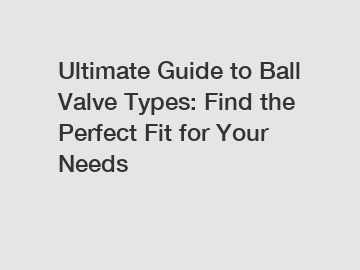Ultimate Guide to Ball Valve Types: Find the Perfect Fit for Your Needs
Ball valves are a versatile and essential component in many industries and applications. They are used to control the flow of liquids and gases in a piping system, making them a crucial part of any fluid handling process.
But with so many different types of ball valves available on the market, it can be overwhelming to choose the right one for your specific needs. In this ultimate guide, we will break down the various types of ball valves and help you find the perfect fit for your application.
1. Floating Ball Valve.

The most common type of ball valve is the floating ball valve. In this design, the ball is not fixed to the stem, allowing it to move slightly in relation to the sealing rings. This design is ideal for applications where tight shut-off is not required, as the ball may not completely seal against the seat.
Floating ball valves are typically used in applications where moderate pressure and temperature are present, such as water distribution systems, oil and gas pipelines, and HVAC systems.
2. Trunnion-Mounted Ball Valve.
Trunnion-mounted ball valves have a fixed ball that is supported by a trunnion, which is a stationary shaft that holds the ball in place. This design provides better support and stability for the ball, making it ideal for high-pressure and high-temperature applications.
Trunnion-mounted ball valves are commonly used in industries such as oil and gas, petrochemical, and power generation, where reliable shut-off is essential.
3. V-Port Ball Valve.
V-port ball valves have a V-shaped ball that provides precise flow control and modulation. This design is ideal for applications that require accurate flow rates, such as in chemical processing, water treatment, and food and beverage industries.
V-port ball valves are available in various configurations, including 30, 60, and 90-degree V-ports, allowing for precise control over the flow of liquids and gases.
4. Cryogenic Ball Valve.
Cryogenic ball valves are designed to withstand extremely low temperatures, making them ideal for applications in cryogenic industries such as aerospace, medical, and pharmaceutical.
These valves are constructed with special materials and sealants that can withstand temperatures as low as -196 degrees Celsius, ensuring reliable performance in extreme conditions.
5. Three-Way Ball Valve.
Three-way ball valves have three ports, allowing them to control the flow of two different fluids or mix two fluids together. This design is commonly used in applications where mixing, diversion, or shutoff of multiple streams is required, such as in chemical processing, water treatment, and HVAC systems.
Three-way ball valves are available in various configurations, including T-port and L-port designs, allowing for versatile control over the flow of fluids.
6. Metal-Seated Ball Valve.
Metal-seated ball valves are designed for applications where high temperatures, abrasive media, or severe service conditions are present. These valves are constructed with metal seats and balls to withstand harsh environments and provide long-lasting performance.
Metal-seated ball valves are commonly used in industries such as mining, pulp and paper, and chemical processing, where reliable shut-off and durability are essential.
7. Multi-Port Ball Valve.
Multi-port ball valves have multiple ports and flow paths, allowing them to control the flow of fluids in multiple directions. This design is ideal for applications where complex flow patterns are required, such as in mixing, diverting, or sampling processes.
Multi-port ball valves are available in various configurations, including 3-way, 4-way, and 5-way designs, allowing for versatile control over the flow of fluids in a piping system.
In conclusion, the type of ball valve you choose will depend on your specific application requirements, such as pressure, temperature, flow rate, and media. By understanding the different types of ball valves available and their respective features and benefits, you can find the perfect fit for your needs and ensure reliable performance in your fluid handling process.
Want more information on 1 Piece Ball Valve Factory, High Quality Mini Ball Valve, Customized Investment Castings Services? Feel free to contact us.

